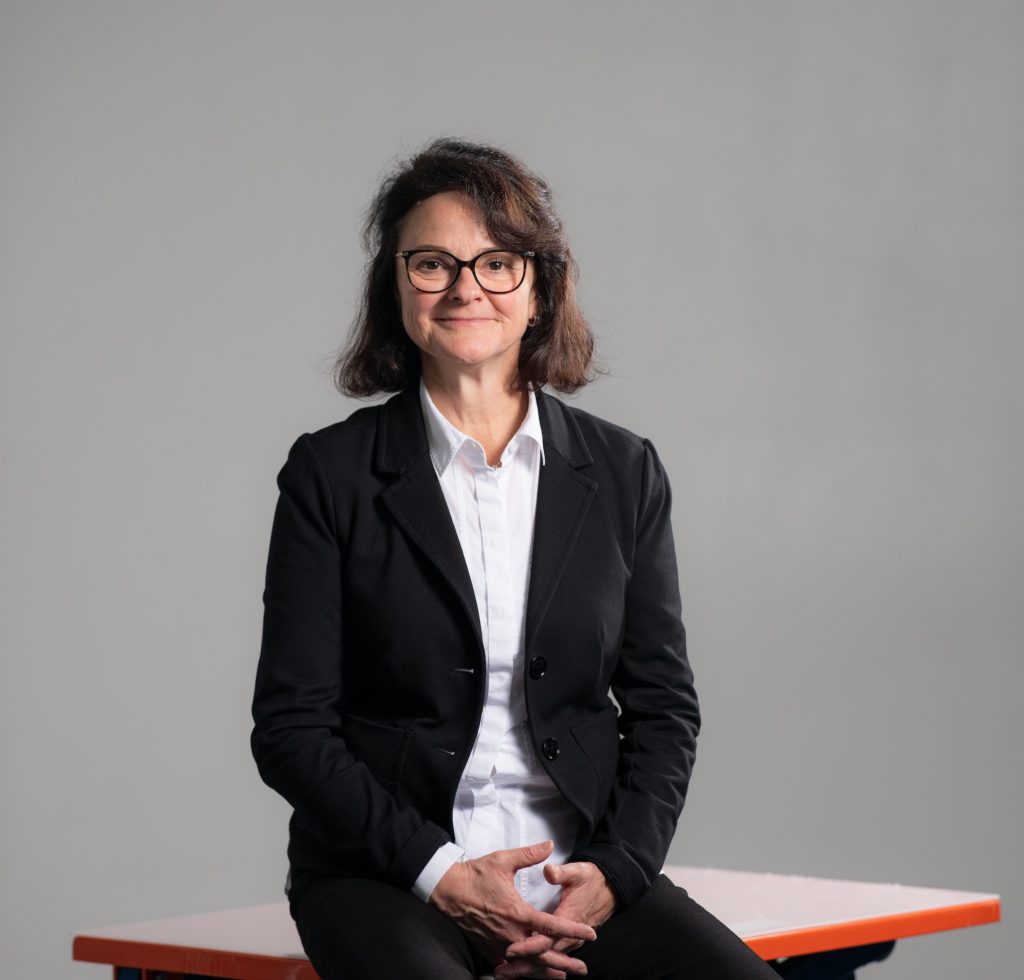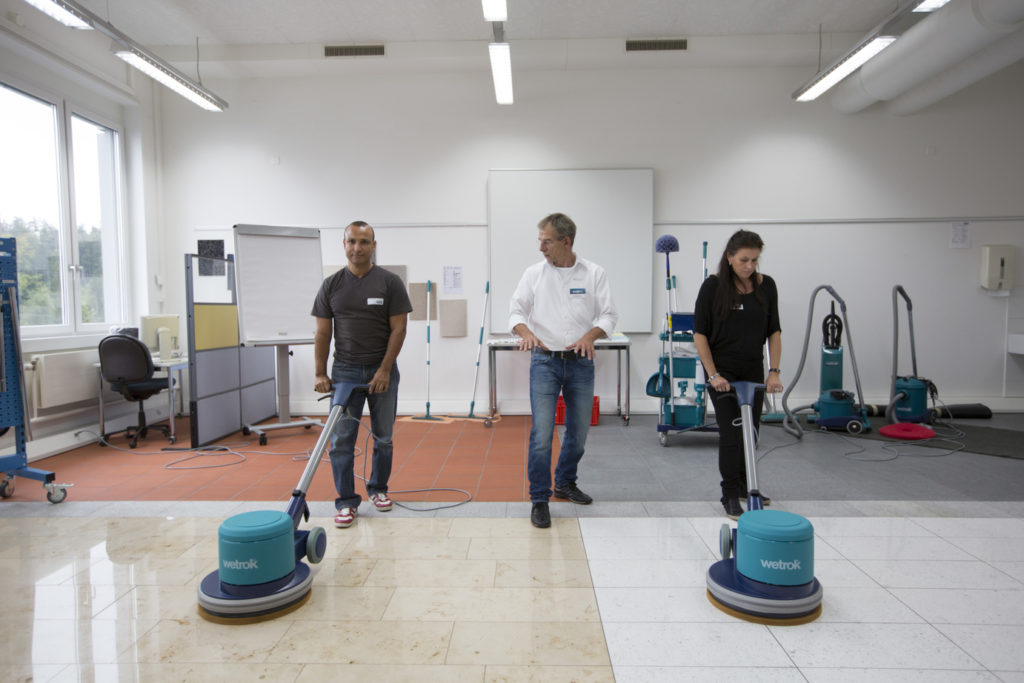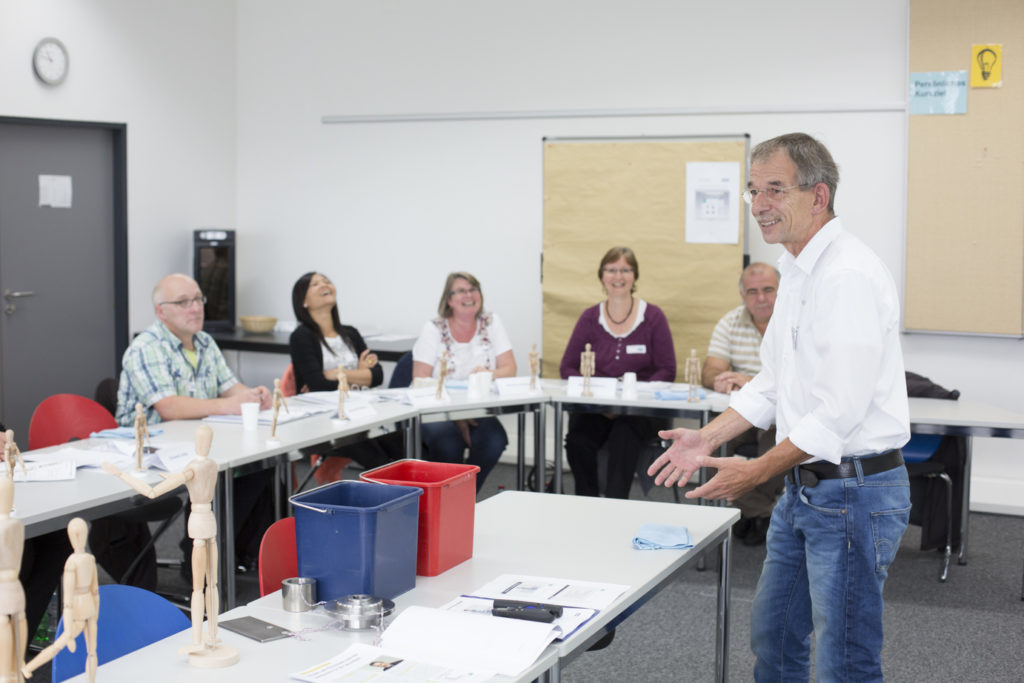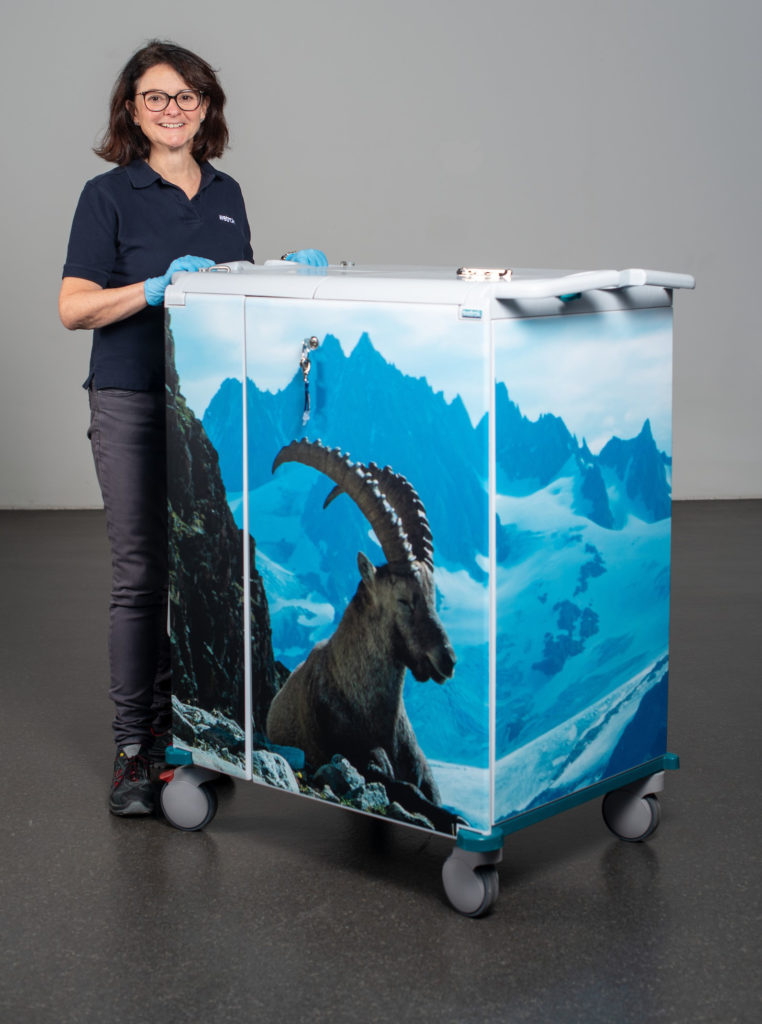How important is training in the cleaning industry?
19.02.2020
Wetrok operates one training centre each in Kloten and Crissier: the Wetrok Academy. Participants can choose from 17 standard courses or a course tailored to the individual needs of the customer and learn everything there is to know about professional cleaning. Academy Director Cristina Weidmann-D’Alessio explains in an interview the difference between cleaners and cleaning professionals, she talks about the ludicrous old wives’ tales still circulating in the cleaning business, and about why robots are far from being able to hold their own with cleaning professionals.
Ms Weidmann-D’Alessio, is cleaning something you have to learn?
Cleaning isn’t, but professional cleaning certainly is! It is important to differentiate between the two. Anyone can clean at home. Professional cleaning, however, is a skill that requires specialist knowledge. Just because we all do it at home, doesn’t automatically mean that we’re doing it right. For example: Non-professionals tend to use warm or hot water for cleaning, thinking it will improve the cleaning result. But that’s a myth! Cleaning products are generally formulated in such a way that cold water is enough. Hot water can even render certain ingredients ineffective and this can have a massive impact on the cleaning effect. Not to mention that using hot water makes no sense from an environmental point of view. These are the kinds of things you learn in a cleaning course.
You make a clear distinction between cleaners and professional cleaners. What’s the difference?
Professionally trained cleaners know how to coordinate all of the most important aspects of cleaning. They use the right cleaning product in the correct dosage for the corresponding surface and type of dirt. This allows them not only to achieve a much better cleaning effect, but also to prevent accidents, damage to materials, and unnecessary but frequently incurred costs. By choosing resource-efficient cleaning methods and the correct dosage, they also ensure that the environment is not unnecessarily polluted. In a nutshell, professional cleaners take responsibility.

The cleaning profession has changed. What new challenges do cleaning staff face today?
The biggest challenge is flexibility – if you are not willing to adapt to change, then everything else is irrelevant. Construction methods and materials, for example, are constantly changing, i.e. new types of flooring that go in and out of fashion. Cleaning staff must therefore have sound basic knowledge and must stay up to date with the latest furnishing trends, so that they can react quickly and flexibly on site. Another aspect that is subject to change is the cleaning methods. It is essential for cleaning staff to gradually replace traditional cleaning methods (such as the water bucket method) with more time-efficient, state-of-the-art methods (such as pre-moistened mops in the WetBox). A third challenge that is becoming more and more important is a competent and neat appearance. In many places (such as shopping centres), cleaning staff are once again becoming increasingly visible to customers and passers-by. This makes them not only part of the company’s appearance, but they are often the first point of contact for customers who need help or have a question. Their appearance (demeanour, state of the cleaning materials, willingness to help) ultimately reflects their cleaning performance – and the reputation of their entire profession.
Do you welcome the fact that cleaning staff are once again becoming more visible?
Absolutely! Cleaning staff have an incredibly important job. They ensure the well-being of customers in a building. This means that they have great responsibility – and that’s nothing to hide! Let me use an analogy to explain how important they are. A company is like a clock with all its cogs. Each cog represents a department, the cleaning department being one of them. If one cog stops working, the whole clock stops working. The company now has a problem – no matter which department has stopped working. People tend to forget that the cleaning team does fundamentally important work. Would you buy something from a high-end shopping centre with attractive product presentation and excellent customer service if the shop windows were smeared and the bins overflowing?
Cost pressure is steadily increasing in the cleaning industry. Does this development have an impact on demand for training measures?
You might think that in a time of strong cost pressure, people would invest less in cleaning training – but the opposite is true. The fact that personnel costs account for up to 80% of cleaning costs means qualified professionals are more in demand than ever. It is essential for companies to fill these costly posts with the best staff available. By choosing and applying the right methods and systems, qualified professionals can improve effectiveness and efficiency.
The Wetrok Academy is Wetrok’s renowned training centre. What types of courses do you offer?
Our courses are divided into three main areas: standard courses, individual courses and workshop days. Standard courses are taught at our training centres in Kloten and Crissier. From floor cleaning and window cleaning to ergonomics courses, we cover all areas of cleaning. The courses last between one and four days with costs ranging from 200 to 1,200 francs. In addition to the 17 standard courses, there are workshop days for prospective caretakers and trainees. On these workshop days, participants hone their practical skills in an exam-like environment to gain confidence. They then receive some final feedback before the exam. The third branch is our individual courses. These can take place either at the customer’s premises or at our training centre.
What is the balance between theory and practice?
Anyone who attends a Wetrok course expecting a long lecture about theory will be disappointed. Both our participants and our experienced course instructors come from practical backgrounds. Our aim is therefore to enable participants to practice and experience as much as possible. Short theory presentations provide important input, but never last longer than an hour. Group work is another important learning area for us. Our courses are 30 percent theory and 70 percent practice.

How many people take part in a cleaning course?
Depending on the course, there will be a maximum of ten or twelve people. We deliberately keep our groups small in order to provide the best level of supervision and to create a comfortable environment.
Are there any elements of the course that cause surprise among participants?
The tests for identifying floor coverings leave a lasting impression on many participants. The fire test, for example, which requires nothing but a lighter and a paper clip. Participants will often pass on these newly acquired skills to their colleagues in team meetings, gaining respect and admiration as a result. Another aspect that regularly causes a stir is the direction in which participants are taught to clean walls – namely from bottom to top. If the cleaning solution was applied the other way round, dirty water running down the dry surface might soak in and stick there (unsightly drip marks). Another frequent cause for surprise is how much time can be saved and the degree to which work can be simplified through new cleaning methods.
You offer a “Master’s” course for cleaning staff. What standing does this training have in the market?
The Wetrok Master is a training course that distinguishes a cleaner as a qualified specialist and manager. This not only gives graduates greater job security, but also more opportunities on the job market in general – including moving up in the hierarchy. For potential employers, meanwhile, the Wetrok Master qualification is a guarantee for quality. Last year, a Master’s graduate told me that the Wetrok Master’s degree was the decisive factor in her being accepted for a new position.
Have you experienced any particularly funny, surprising or touching moments during the cleaning courses?
Unenthusiastic participants who are lacking motivation are the greatest challenge. Once, a participant told me at the start of a course that he’d rather go to the dentist for root canal treatment than take part in the training course. As the day went by, however, he opened up more and more and his interest grew. At the end of the course, he took back what he said and left the room with a smile on his face – that made me very happy. I once had a touching situation with a participant who associated learning with bad experiences because of her time in elementary school. She hardly dared enter the course room at the start because she felt she wouldn’t be able to handle the learning content. At the end of the fourth day of the course, she came up to me and said that she had not only learned a lot for her working life, but had also had a lot of fun. This example shows: A pleasant, fun and enjoyable learning environment has a great influence on learning success.
What industries do the course participants come from and what age groups or genders are represented?
The groups are very mixed in terms of industry, age and gender. However, one group of participants has grown noticeably: people who are re-training as cleaning professionals. Contrary to common belief, the professional cleaning industry is not predominantly made up of women, but rather men. The gender ratio is quite balanced in our courses, but there tends to be a few more men.

Do men and women behave differently in class?
I often see women who are insecure or nervous when it comes to handling large cleaning machines. Once they get the hang of using them, however, they enjoy working with them. The opposite tends to be true for men. Many are very confident at the start of a course, feeling they already know everything. However, this attitude usually changes over the course of the training and they become more open to new skills and knowledge.
Has the media used for teaching changed?
The trend towards visual content instead of text is also reflected in our company. You can’t avoid using illustrations, pictograms and photos.
What would you recommend to newcomers or people re-familiarising themselves with the industry, who want to acquire sound basic cleaning knowledge in a short space of time?
Our “Modern cleaning practices” class is ideal for beginners. In this four-day course, newcomers to the cleaning industry can acquire the basic knowledge required for modern cleaning. The course provides an overview of cleaning products, machine operation, different materials to be cleaned and cleaning methods. Think of it as a helicopter flight over the world of cleaning. You cover a large area and where there are particularly interesting details, you touch down and stay for a short while. In addition to our basic cleaning course, I definitely recommend that newcomers to the cleaning industry seek practical support. They should accompany a caretaker or building cleaner and help them with their work for a week. This is the only way for beginners to gain confidence when it comes to using methods, machines and products.

You mentioned individual courses earlier. Who are they for and what advantages do they hold over your standard cleaning courses?
The advantage of individual courses is the freedom of choice. They take place at the customer’s premises and the training content, depth and pace can be selected by the customer. By training at their place of work, cleaning staff can train with the actual machines and cleaning products that they use day to day, and special attention can be paid to specific surface materials or floor coverings. Many cleaning team leaders also see this type of individual training as a team building event.
Do you feel that cleaning staff are undervalued?
Yes, unfortunately, that’s still the case. People who are not involved in cleaning often still think of cleaning staff simply as the “help”. This makes me sad because cleaning staff play a key role in any building and are often the only guarantee for a safe environment. Just imagine if the cleaning department of a large company were to go on strike – it would bring the entire customer traffic to a standstill. Above all, however, I find fault with the fact that cleaning staff so rarely receive explicit recognition in everyday life. A little smile or some sincere praise would brighten up the working day of many a cleaner.
Let us finally take a look to the future: Will we even need qualified cleaning staff ten years from now, or will they have been replaced by robots?
Robots will never replace an entire team of cleaners. They can undoubtedly provide support for repetitive, highly standardised task. However, human cleaning power will continue to be needed to meet different customer expectations and perform more complex tasks. I am referring specifically to the healthcare sector, where cleaners perform a wide range of additional tasks that require sensitivity, responsibility and empathy. The working environment will change, however, and cleaning staff will have to acquire new skills and know-how as a result. When humans become the “bosses” of robotic team members, they will need different, more specific knowledge than before. Once again, this just shows that the only constant in cleaning is change.
